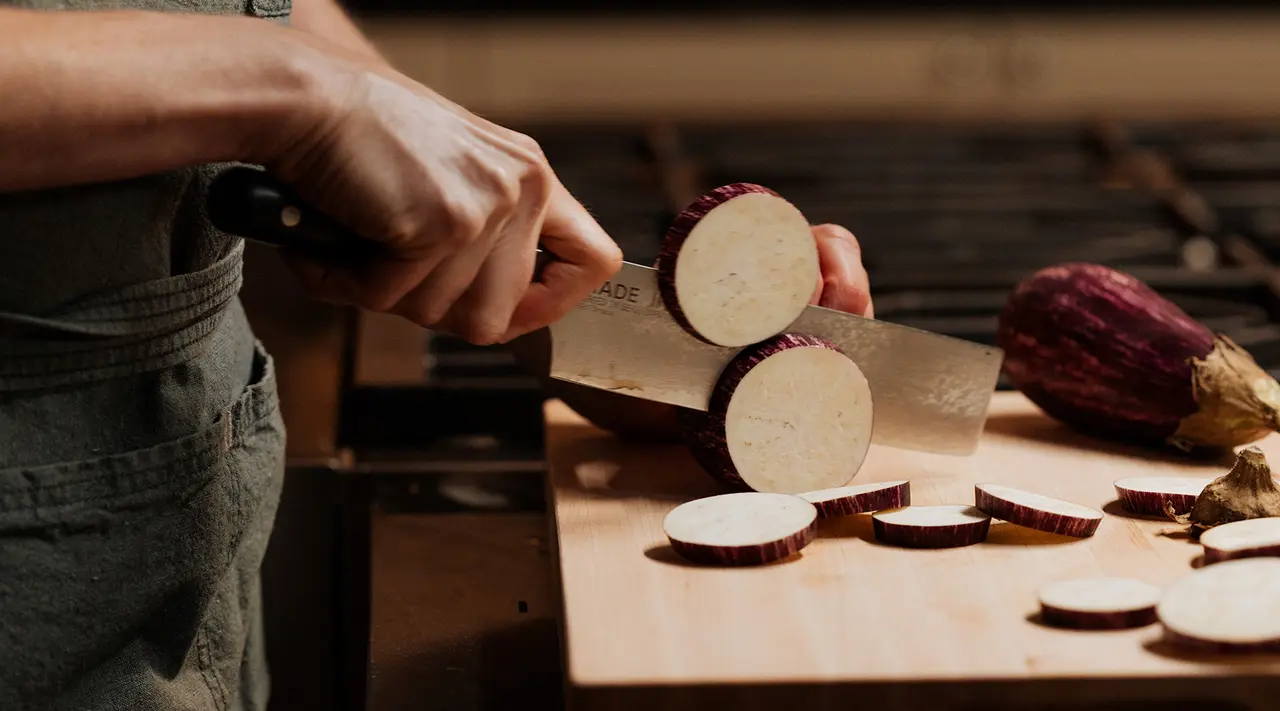Eggplant can be a divisive ingredient—it’s one of those foods people either love or hate. But if you’ve only had bitter, soggy eggplant, much like mushrooms, there’s a chance you haven’t had it prepared well. If treated properly, eggplant can be a tender, flavorful addition to a variety of dishes.
Here we will break down how to shop for eggplant, considerations when preparing them, and the cooking methods that suit this ingredient best. Even if you think you’re not an eggplant fan, try at least one of these dishes just to make sure.
How to Shop for Eggplant
There are many types of eggplant, each well suited to different dishes. Most are in season during the late summer, with peak months being July to October in North America, depending on the region. The two most common types of eggplants are globe and Italian. Both are large (Italians are slightly smaller), have deep purple skin, and can often be found in supermarkets. If at all possible, try to buy your eggplants locally so they’re as fresh as possible. If you have access to farmer’s markets, you will also likely be able to find a greater variety.
How to Prep Eggplants
Prepping eggplants depends on which variety you choose and what you’re doing with them. The skin is edible, but depending on the dish, you can peel eggplants either using a vegetable peeler or carefully with a Knife. For cutting eggplant, we recommend the Nakiri, as its flat, blunt-tipped blade is designed specifically for chopping vegetables. A Santoku would also work well.
While Japanese, Chinese, and Thai eggplants have a mild flavor, the other types benefit from salting before cooking to reduce its bitter flavor and make it easier to digest. To do this, simply cut your eggplant according to the recipe and place it in a colander, or the Pasta Insert.
Sprinkle generously with salt and let it drain over the sink while you prep the rest of your ingredients or for at least 30 minutes. When you’re ready to begin cooking, rinse and blot dry with paper or kitchen towels if needed. When you’re seasoning the dish, keep in mind that your eggplant will have absorbed some of that salt.
How to Cook Eggplant
Eggplant can be cooked in many different ways, both on the stove, in the oven, and on a grill. Make sure you cut your eggplant right before cooking with it, as it oxidizes quickly. Here are some of our favorite preparations.
How to Fry EggplantBecause it’s so absorptive, eggplant takes well to frying. If batter or breading is involved, then it adds another layer to soak up sauce. You can also flash fry eggplant to preserve its color and texture before tossing it into a flavorful sauce.
To fry an eggplant, first cut into your desired shape. Circles are great for eggplant parmesan. Dredge the slices if desired and fill a Saute Pan about ⅓ full with a neutral oil. Let the oil come up to temperature and gently lower in the slices. Fry until golden brown, about 3–4 minutes per side. Remove from the pan and let them drain on paper towels, sprinkling with salt to keep them crisp.
How to Roast EggplantAs with all vegetables, roasting brings out the eggplant's natural sweetness. Roasted eggplant is wonderful as part of a hearty main and pairs well with feta, harissa, and warming spices. It can also be added to a dip like baba ganoush or caponata.
Eggplant can either be sliced in half or cubed before roasting. If cutting it in half, you may want to score the flesh so your seasoning sinks in better. Brush or toss with olive oil and desired seasonings, place in a Roasting Pan, and roast at 425F for 25–30 minutes for cubes, 40-50 minutes for halves.
How to Grill EggplantIn the summer, there’s no better way to eat eggplant than cooked on the grill. The smoky flavor pairs well with eggplant’s earthy sweetness, and it can be seasoned like meat. Grilled eggplant is delicious tucked into a warm pita or as part of a kebab with pieces of onion and peppers.
You can cut an eggplant for grilling in the same ways you would above for roasting. If your eggplant is cut into cubes, the thoughtfully designed perforations of our Grill Frying Pan keep it from falling through the slats. Brush or toss with oil and grill on medium-high, until charred on both sides.
How to Bake EggplantWhile roasting eggplant usually involves cooking it to caramelized perfection, baked eggplant is soft, and so tender it’s almost silky. It’s often baked with tomato in one form or another, either in sauce form or fresh, and since you’re not baking in Carbon Steel, you won’t need to worry about stripping the seasoning.
You can bake your eggplant in any shape—from cubed, to sliced in circles, to halved. Depending on the dish, any of our French Porcelain Bakeware would be a great choice. Bake in a 350–375F oven until soft but not mushy, 30-50 minutes depending on the cut and the recipe.
Ready to Cook?
Now that you know how to cook an eggplant, four different ways, we would be lying if we said that eggplant parmesan wasn’t one of our favorites. Eggplants are sliced, fried until crisp, and then layered into our Oval Gratin Dish where they soak up all of that red sauce and cheesy richness.























